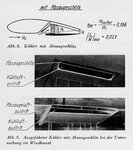- Thread starter
- #41
In the case of the wide, low radiator ducts, as used on the Spiteful, there was actually boundary layer thickening on the roof of the duct. The boundary layer air is not moving very quickly relative to the aircraft, so this reduced the effectiveness of the radiator. I can't recall exactly how much of the radiator the boundary layer covered, except that it was around 1/8 the depth of the radiator. Which is significant. This was from tests done of the production style Spiteful radiators.
Another solution was to provide a duct the entire length of the radiator duct, gong above the radiator.
Is this what you mean?
Bf 109 F
This shallow bypass air duct for boundary layer extraction is only available on the Bf 109 F.
Due to the increased flow velocity of the air flowing through, the channel only reduces the air resistance which the cooler housing generates.



